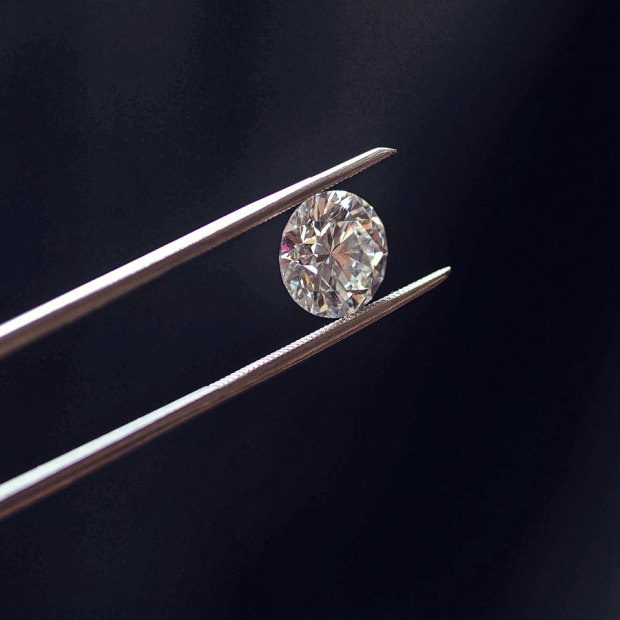‘A half-carat isn’t going to cut it’: The Millennials sparking a diamond revolution
Good Weekend Magazine
Published on 15th July 2022
By Sian Powell
Sydney Morning Herald, The Age Melbourne & The Brisbane Times.
Alexis Clarke’s strawberry-blonde hair is pulled back from her face, and she’s wearing no-nonsense black leggings, black running shoes and an olive-green puffer jacket on this chilly day in Thirroul, a northern suburb of the NSW coastal city of Wollongong. Glowing slightly, she looks as though she’s just been to the gym (in fact, she has).
But we’re not meeting in this ordinary cafe to discuss gyms or fitness, or to moan about the damp, chilly weather or even to chew over the highlights of the one-time coal-mining village of Thirroul. We’re here to talk about diamonds, those brilliant multifaceted cut gems that have funded wars, stoked conflict, graced the heads of royalty (both Hollywood and actual) and sparkled from millions of ring fingers around the world.
On Clarke’s hand shines a ring that both tells the world she’s engaged to be married and serves as a symbol of a global upheaval in the multibillion-dollar diamond industry. Her engagement ring is a thing of delicate beauty and twinkles when she moves her hand. The central diamond is flanked by smaller diamonds on a band of 18-carat gold. So far, so traditional. But these diamonds were created, rather than dug out of the ground. It’s a revolution that has divided the industry.
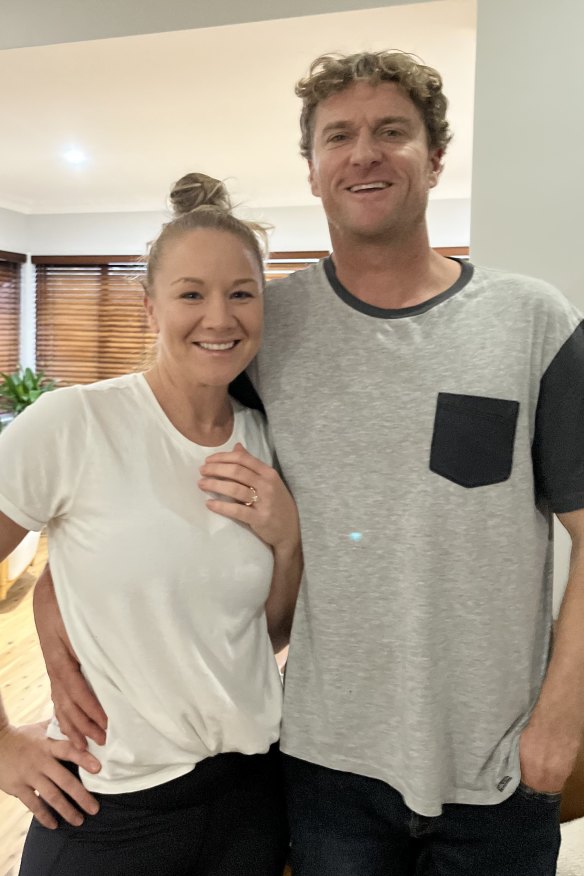
Alexis Clarke (with fiancé Trent Akhurst) chose lab-grown diamonds for her engagement ring.
Clarke, 38, adores her thoroughly modern ring. She designed it herself and it turned out exactly as she’d hoped. She holds her hand out and smiles, “I love it. And it’s forever.”
Chemically and physically identical to mined stones, the so-called “lab-grown” diamonds in her ring are often described as “factory grown” and “synthetic” by critics who shudder at the incoming tide of man-made gems. Yet even experts need specialist equipment to tell the difference between them; to know whether a stone has been matured for billions of years in the earth’s mantle or produced in a matter of weeks or days in a lab or factory.
Traditionalists point out that these man-made diamonds are rapidly losing value as manufacturing techniques are refined and production increases. They say the stones are environmentally suspect because creating diamonds requires immense amounts of energy (although it has yet to be finally determined whether more energy, in total, is needed to make one than to pull it out of the earth). On the plus side for consumers, the stones are considerably cheaper: there’s simply a lot more bling for your buck. Many are voting with their wallets – twice or three times the size for the same price? Yes, please.
New Zealand-born Clarke has lived with her Australian partner, Trent Akhurst, for 10 years. They own a house a few minutes from central Thirroul and have a five-year-old daughter. The family just spent 12 months travelling around Australia in a caravan. Akhurst, 46, works in a nearby coal mine, and the couple own and run an online company, At Health Australia, which provides organic protein powders and collagen supplements to health food shops and the like.
Last year, Akhurst said he wanted to cement their commitment to a life together. He wanted Clarke to design the ring, then he would formally ask her to marry him. “He actually brought it up, saying, ‘I think it’s time, but can you choose the ring, and once I’ve got the ring, I’ll propose, in my own time,’ ” she says with a smile. “I found it overwhelming, choosing the ring for myself, I don’t know how guys choose. It’s such a huge decision and choice.”
Sipping an almond chai latte in the cafe, Clarke says she had an idea of what she wanted her ring to look like, but it took her a long time to get started. Travelling through remote Australia in a caravan was not conducive to finding high-end jewellery, and the pandemic lockdowns meant she couldn’t try on engagement rings for size and shape in shops. She finally found the design she wanted on Instagram, took a screenshot and filed the image away.
A little later, listening to a business-oriented podcast that she likes, she was struck by the ideas of jeweller Lauren Chang Sommer, co-owner of the Sydney-based lab-grown diamonds specialists Moi Moi Fine Jewellery.
“I was immediately drawn to it,” Clarke says. “Just in terms of knowing where your diamonds come from. She also spoke about them being more ethical for the planet. And I’d always wanted quite a big diamond. How often do you make a purchase like this? Once in a lifetime. So you want it to be really special, and I didn’t want the price to limit my options.”
Clarke had been wearing her grandmother’s classic engagement ring, set with a beautiful old garnet, and she loved it. But Akhurst wanted her to have a ring that he could give to her. “I was open to other gemstones,” she says, “but for me it really comes down to a diamond lasting forever; everything a diamond symbolises in terms of weddings. It just felt right to have a diamond.”
Her collaboration on the ring design was conducted online. She sent the screenshot image to Moi Moi, and in return received detailed computer drawings and eventually a render. The couple’s budget bounced up a little, but with a house and a child they were pragmatic, and the final price came in at a little under $10,000.
Advised by Moi Moi, she eventually settled on an oval-cut, 1.67 carat, white centre diamond flanked by an alternating combination of four small marquise
diamonds (a narrow eye-shaped cut with pointed ends) and four small round-cut diamonds – adding up to two carats. The central diamond came with a third-party grading report confirming the stone’s colour, clarity, carat and cut.
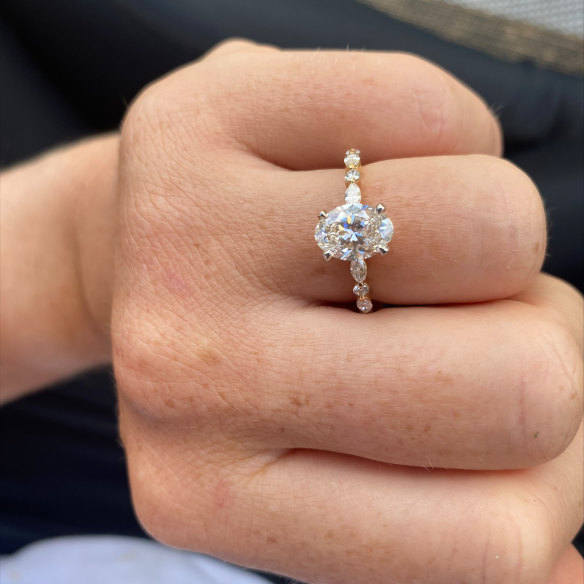
Clarke’s engagement ring, designed in collaboration with Sydney jeweller Moi Moi, came in at just under $10,000.
To begin with, Clarke took her ring off for safekeeping when she went surfing, but she’s now sure it won’t come off, so it stays on her finger all the time. “It’s exactly how I wanted it,” she says. “If I’d not gone with a lab-grown diamond, I would have had to sacrifice some size, I think, which would be a shame.” She doesn’t care if the diamonds were manufactured rather than mined. “We’ve ripped [them] out of the earth in these dirty environments; there’s nothing glamorous about the mining industry.”
She picked the ring up in January, and later that month, when the family were holidaying at a favourite camping and surf spot in Crescent Head, on the NSW Mid North Coast, Akhurst went down on a knee and asked her to marry him. Their daughter looked on. “It was magic,” Clarke says. The wedding will be in summer next year.
Technicians from the US firm General Electric manufactured the first diamonds in 1954, but it took decades to refine the techniques and produce larger and cost-effective gem-quality stones. Their original HPHT (high pressure, high temperature) method uses a large mechanical press to simulate the conditions that prevail deep in the earth’s mantle. Extreme pressure and high temperatures are applied to a diamond seed, which becomes a kind of template for carbon to grow in a lattice, layer by layer.
This technique has now largely been replaced by chemical vapour deposition, or CVD. The seed is put into a plasma reactor chamber and a mix of gases – including, usually, carbon-rich methane – is added at very low pressure. The gases are heated to create plasma, breaking the molecular bonds. Carbon atoms attach to the seed, which slowly grows, again layer by layer.
Both methods use enormous amounts of energy. The champions of mined, or natural, diamonds note that by far the most manufactured diamonds are produced in China, followed by India, and that neither nation is known for promoting high environmental and labour standards. According to a report published in February on the state-owned China Daily website, China produces about half the world’s supply, mostly in Henan province, in central China, where the small city of Zhecheng has become known as the nation’s diamond capital, and where billions of yuan (hundreds of millions of dollars) have been invested in diamond-producing facilities.
On the second floor of Sydney’s palatial Queen Victoria Building, Lauren Chang Sommer gazes over the extensive Moi Moi jewellery store she founded with her sister, surveying the high arched windows, the lush cerise carpet and the wide range of lab-grown jewellery on display: rings, earrings, bracelets and necklaces shimmering in their glass cases. Wearing a conservative black suit and intensely pink high heels that match the store’s shocking pink sofa, she is, of course, sparkling with diamonds: in her ears, on her hands, around her neck.
She and her sister are Sydney-born and -bred, with an Australian mother and a Chinese-Malaysian father, who settled here as a teenager. The sisters set up shop in 2004 selling moissanite, another lab-grown jewel. This inspired the name Moi Moi, which also means “little sister” in Cantonese, a language spoken by their father.
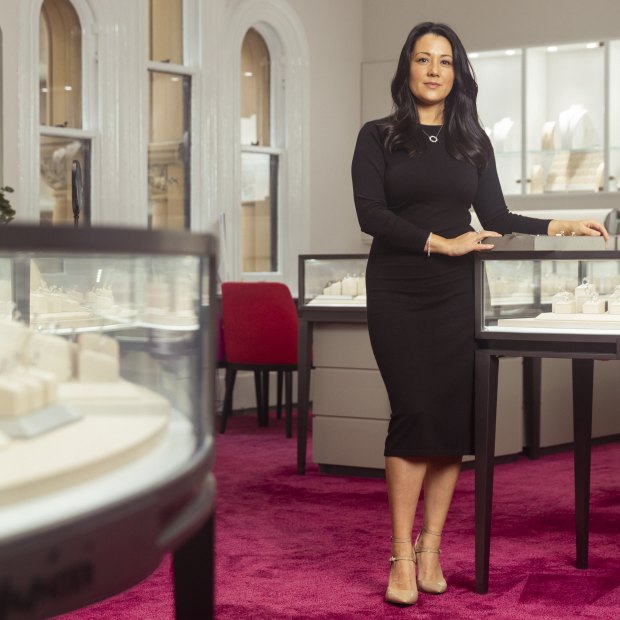
Lauren Chang Sommer of Moi Moi Fine Jewellery. She started selling lab-grown diamonds more than two years ago and says demand has surged. CREDIT: DOMINIC LORRIMER
Moi Moi launched into lab-grown diamonds as a natural progression, becoming one of the first Australian jewellery companies to be fully invested in both the HPHT and CVD varieties. “It’s an entirely new concept, an entirely new category for the jewellery industry,” Sommer says.
The provenance of most such diamonds is traceable, she argues, via a tiny identifying individual laser inscription that’s invisible to the naked eye. Still, Moi Moi sources stones from a trader, and Sommer doesn’t always know where the diamonds were made. “You can tell but not always. These things will become more defined as we evolve as an industry.”
A growing number of modern buyers want to ensure the stones they choose are not tainted by association with violent warlords, or organised crime, or exploited labour, or Third World environmental carnage. They want to know how sustainable the mines are, how many tonnes of rock and dirt have to be shifted per carat of mined diamond. They can also raise an eyebrow at lab-diamonds, especially if the provenance is unclear.
Last year, Pandora, the Danish company that makes much of the world’s high street jewellery, announced it would henceforth use only lab-grown diamonds (and nothing but recycled precious metals from 2025) for the sake of sustainability. Industry bodies including the Natural Diamond Council, the World Jewellery Confederation and the Responsible Jewellery Council were quick to respond, issuing a joint statement to say the diamond trade employs tens of millions of people, and that many people in developing nations rely on income, and other benefits, from the mining. The announcement, the group added, could “have unintended but substantial consequences”.
One industry sceptic notes that since Pandora’s diamond jewellery accounted for as little as 0.2 per cent of its sales, the campaign was more of a publicity stunt than anything else.

Lab-grown diamonds are chemically and physically identical to mined stones.
PHOTO CREDIT: DOMINIC LORRIMER
Yet there are real concerns about environmental costs. Last July, toxic waste from Angola’s biggest diamond mine leaked into waterways, killing at least 12 people down river in the Democratic Republic of Congo. In Sierra Leone, residents of Koidu are suing the operators of the Octea diamond mine, claiming in a class action that the operators dumped mine waste and damaged their homes.
The 2006 film Blood Diamond, starring Leonardo DiCaprio, told a story of warlords funded by diamond mines during Sierra Leone’s brutal civil war. The film rattled the diamond industry and insiders insist the certification systems in place, such as the Kimberley Process, have all but eliminated the trade in conflict gems. Yet ethical issues haven’t been eliminated, with reports of Zimbabweans tortured for allegedly trespassing on the nation’s Marange diamond fields.
Much of the jewellery industry, including the luxury brand Tiffany & Co, now refuses to buy diamonds from mines in Zimbabwe or Angola. But the provenance of a substantial proportion of mined gems is difficult to track as it twists through dealers and buyers, and diamond mining giant De Beers is
expanding and refining its blockchain tracing system so stones can be followed from mine to retailer.
A few celebrities are voting with their ears, wrists, necks and fingers. Meghan Markle has been seen wearing lab-grown diamond earrings, while Bindi Irwin, daughter of the famed television personality Steve Irwin, has a lab-grown diamond engagement ring.
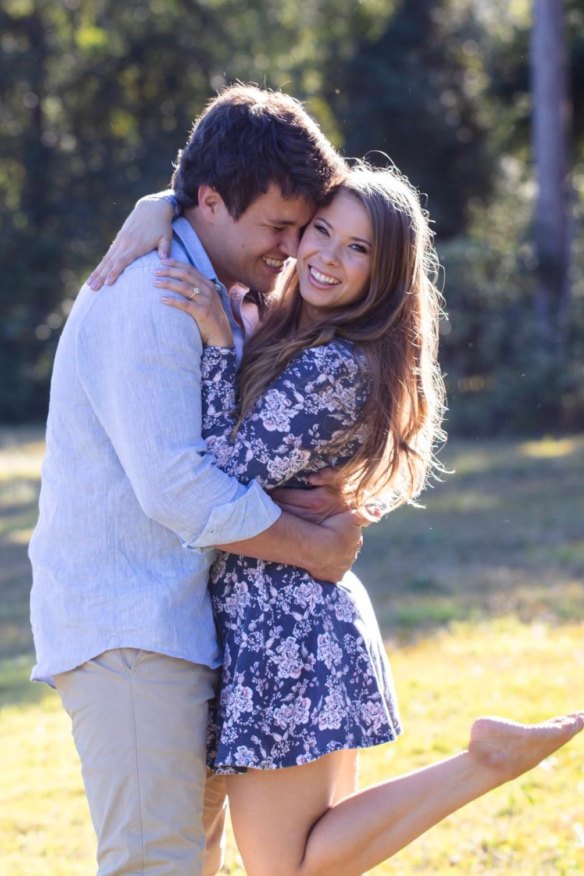
Bindi Irwin has a lab-grown diamond engagement ring from her partner Chandler Powell. CREDIT: TWITTER/BINDI IRWIN
Moi Moi has been selling these manufactured jewels for two-and-a-half years now, Sommer says, and demand has surged. In 2018 she went to the Las Vegas launch of Lightbox, the lab-grown diamond range from De Beers – the company that had a near monopoly on the gem’s trade until the end of the 20th century. It still accounts for one-third of the world’s supply, with mines in Botswana, Namibia, South Africa and Canada.
In the post-World War II years, with diamond prices slumping, De Beers focused on engagement rings with the wildly successful 1948 “A Diamond Is Forever” campaign, a line which continues to influence buyers today. Ordinary diamonds aren’t particularly rare, but over the decades the jewels have become entwined in myths of luxury and scarcity – and the idea that true love is signalled with a large rock on a gold band, hauled at great effort from the bowels of the earth and sanctified with gradings and certificates and maybe even the spice of danger.
In 2020, seemingly bowing to the inevitable market shift, Lightbox opened a factory in the US that can produce more than 200,000 polished carats each year. De Beers now sells these Lightbox diamonds for as little as $US800 ($1175) per carat, regardless of the size of the stone. The basic price increases in a linear manner: $US800 for one carat, $US1600 for two carats, and so on. This is markedly different from mined diamonds, which have prices that grow exponentially as stones get bigger, and rarer.
At the De Beers Lightbox launch in the US, Sommer was surprised to see the gems being promoted as lower-tier jewels: stones for younger women or lesser celebrations. The Lightbox website has encouraged consumers to consider “Gifts for Your Grad” and doesn’t even mention engagement rings.
De Beers says such stones are for a different mood. “Our research demonstrates that most consumers see lab-grown diamonds as being ideally suited to fashion jewellery for lighter occasions,” a press officer tells Good Weekend, adding that “people overwhelmingly prefer natural diamonds for celebrating the most meaningful moments in their lives”.
Sommer says she was astonished by the Lightbox promotion of lab-grown diamonds for “Sweet 16” gifts and the like, adding the audience of jewellers at the launch was annoyed by the assertion. “They [Lightbox marketers] were saying lab-grown diamonds are prosecco and mined diamonds are French champagne. It just seemed so outdated. It seemed offensive. I think they misread the fact that consumers are educated enough these days to be able to make their own decisions.”
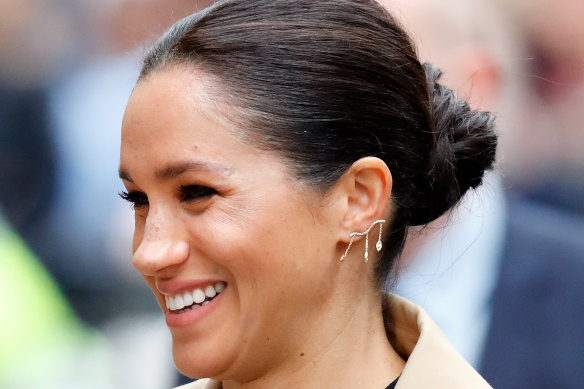
Meghan Markle sporting lab-grown diamond earrings in 2019. CREDIT: GETTY IMAGES
Champagne or not, many buyers simply want big stones. Buyers who could never afford a large mined stone that might retail for tens of thousands of dollars can splash out on a lab-grown diamond. “Millennials and Gen Z today, they want size,” Sommer says. “They want something that looks really good on their social media pages. I’m sorry to say, a half-carat stone isn’t going to cut it any more.”
Click here to read the article in full.
 Track Your Order
Track Your Order


